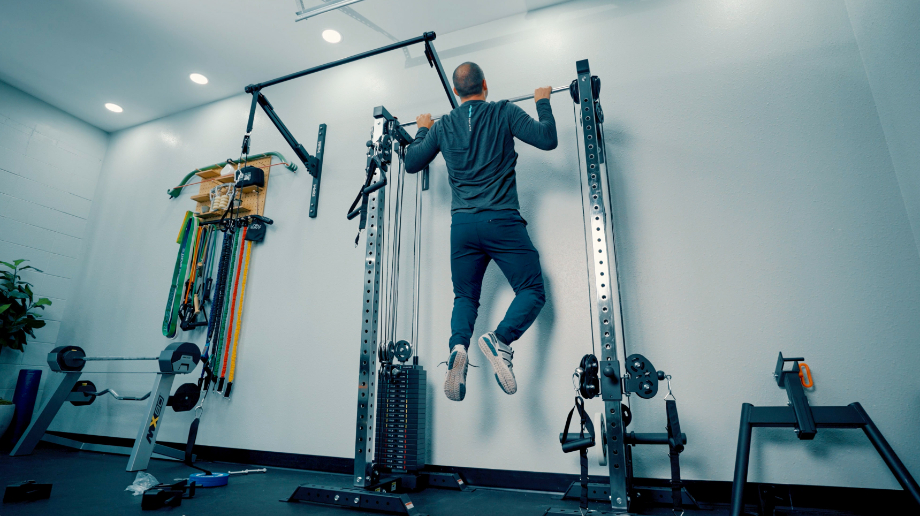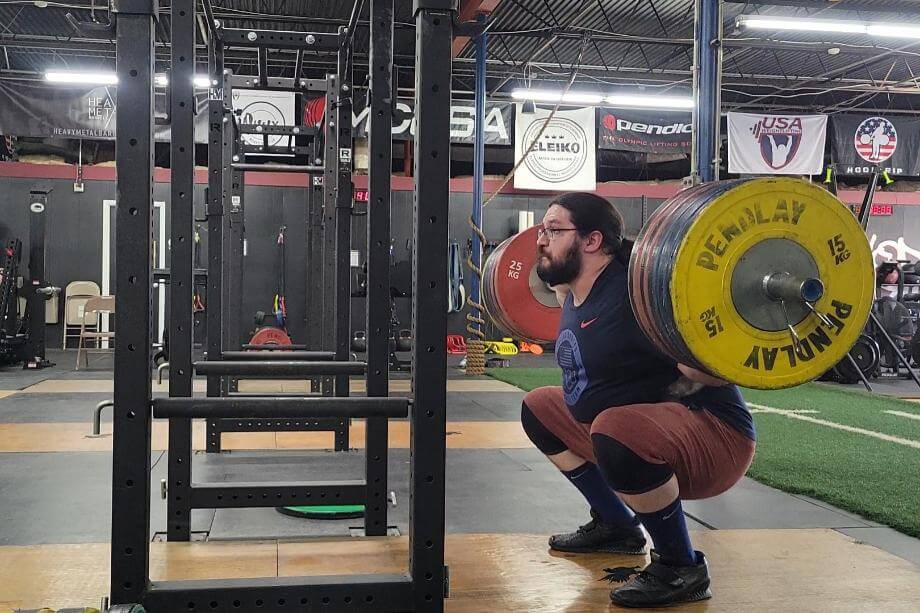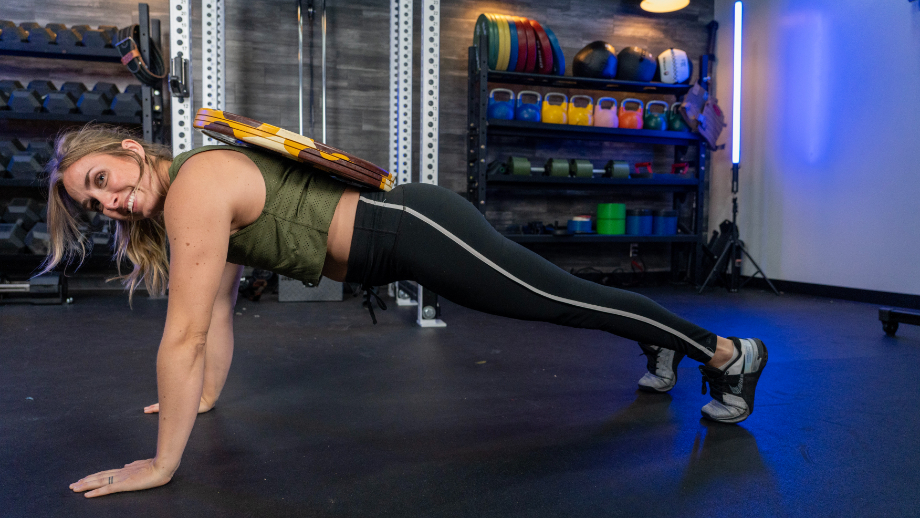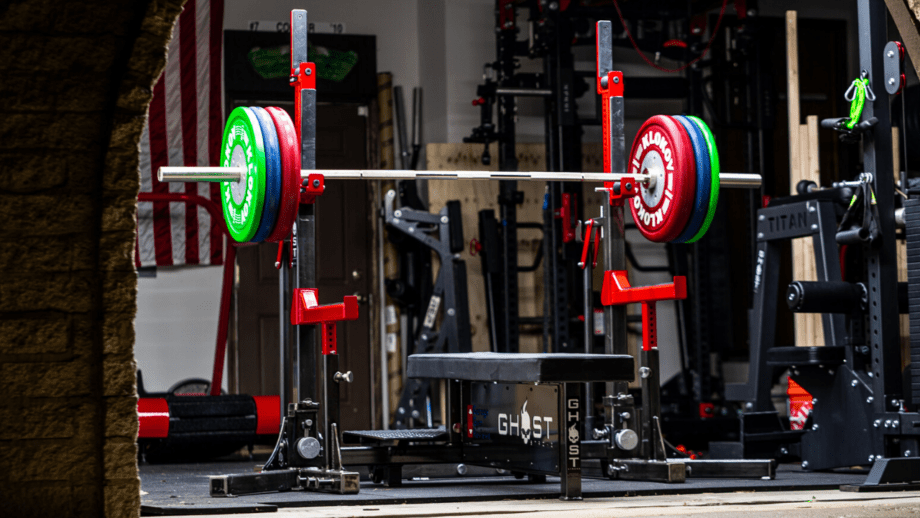We’re always down to try new and exciting fitness trends and programs, but sometimes, you just can’t beat the fundamentals that have always given people the results they’re after.
One of the best examples is the pull-up, the undisputed king of bodyweight exercises and a cornerstone of any comprehensive calisthenics program. This simple but effective movement is awesome for building muscle and strength in the upper body and core. It’s also a minimalist’s dream since all you need is a pull-up bar and your determined self.
The problem is—pull-ups are hard. Studies show1 that many people can’t complete a single rep. Thankfully, we have Kate Meier, NASM-CPT, USAW-L1, CF-L1, and GGR senior director of fitness content, sharing the best pull-up variations for all skill levels—even beginners can begin building the upper-body strength needed to start incorporating pull-ups into their routine.
RELATED: How To Do a Pull-Up
How To Do a Standard Pull-Up
Muscles worked: Lats, traps, rhomboids, rear delts, biceps, core
How to do it:
- Hold onto a pull-up bar with an overhand grip and hands approximately shoulder-width apart.
- Lift your feet off the ground to drop into a dead hang position. Bring your chest up, pinch your shoulder blades together, and slightly arch your back for the starting position.
- Begin pulling yourself up toward the bar using your back muscles.
- Continue until the bar reaches chest level, then squeeze your lats.
- Slowly lower yourself back into the dead hang position while maintaining control.
- Repeat for reps.
RELATED: What Muscles Do Pull-Ups Work?
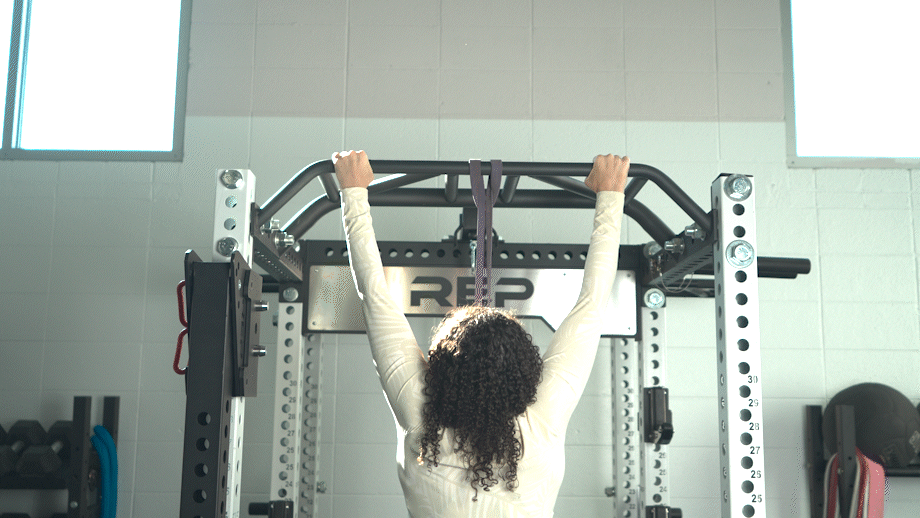
13 Best Pull-Up Variations
The standard pull-up is difficult, so we’ve got pull-up variations for all skill levels as you master your form. Start with some of our beginner variations and work your way into the intermediate and, in time, the advanced pull-up variations. You can also experiment with different grips—such as close-grip or wide-grip—as you progress.
Beginner
- Inverted row
- Dead hang
- Negative pull-up
- Jumping pull-up
Intermediate
- Band-assisted pull-up
- Kipping pull-up
- Chest-to-bar pull-up
- Towel pull-up
- Weighted pull-up
Advanced
- One-arm pull-up
- L-sit pull-up
- Typewriter pull-up
- Archer pull-up
Inverted Row
Why do it: “Inverted rows involve many of the same muscle groups you’ll need to perform pull-ups, but they’re easier to do,” says Kate Meier, NASM-CPT, USAW-L1, CF-L1. “So, starting out with movements like the inverted row will be integral for training the muscles we’ll need later for proper pull-ups.”
How to do it:
- Rack an empty barbell low enough that there is enough room for you to grip the bar with your arms fully extended and your back off the floor.
- Lie beneath the bar, reach up, and take hold using an overhand grip.
- Step your feet out so that your legs are fully extended.
- Brace your core and pull your chest toward the bar using your back muscles.
- Squeeze the contraction, then slowly lower yourself back down to the starting position.
- Repeat for reps.
RELATED: Bent-Over Row Variations
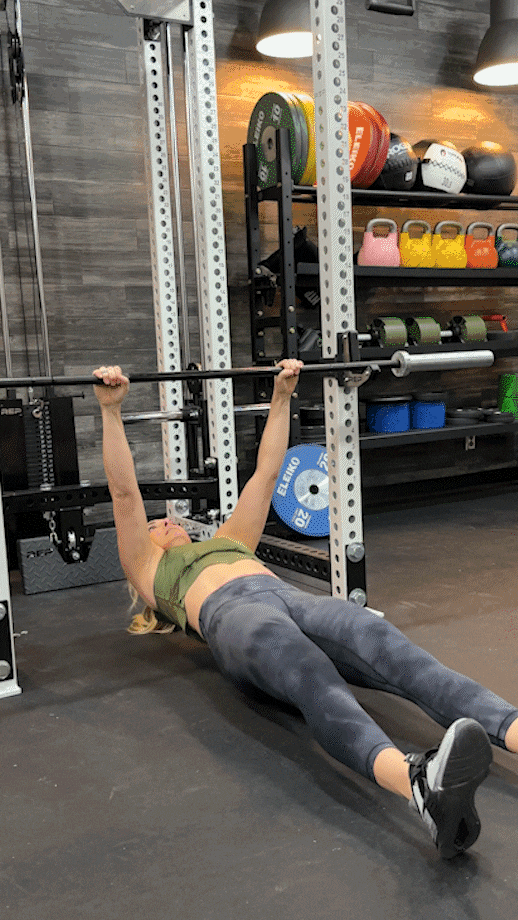
Dead Hang
Why do it: Pull-ups involve producing power to pull your body upward, but starting out with a simple isometric dead hang helps train the muscles involved while building grip strength, too.
How to do it:
- Grip a pull-up bar using a pronated grip and enter the dead hang position. You’ll want fully extended arms, a tight core, a neutral neck and spine, and your legs lifted off the floor.
- Hold the position for the desired duration, then release.
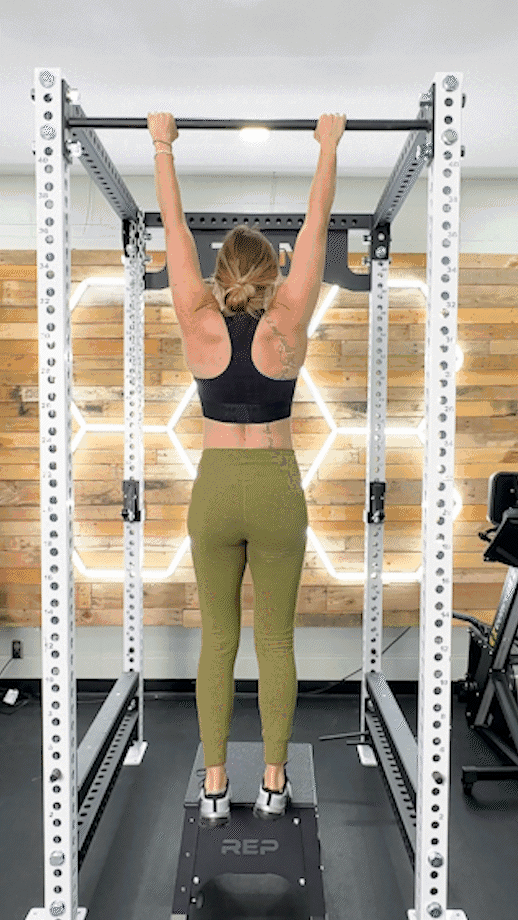
Negative Pull-Up
Why do it: Negative pull-ups effectively remove the concentric phase (shortening of the muscle) of the pull-up to focus on the arguably more effective eccentric phase (lengthening) instead. The idea is to use your muscles for a more slow and controlled descent into a dead hang.
How to do it:
- Set up a bench, plyo box, or other raised platform under your pull-up bar so you can begin the exercise from the top position of the regular pull-up.
- Step off the elevated surface and use your back muscles to slowly control your descent.
- Continue until you reach a dead hang.
- Release, then get back up into the peak position and repeat.
RELATED: Eccentric Training
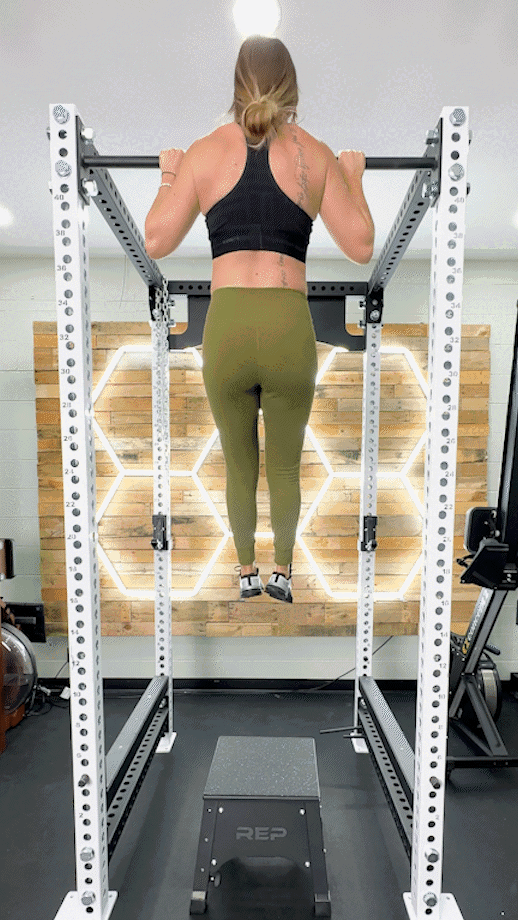
Jumping Pull-Up
Why do it: “The negative pull-up removes the concentric phase, but the jumping pull-up assists the concentric phase,” says Kate. “You use your jump to help, then take over with your muscles to complete the concentric phase and control the eccentric phase.”
How to do it:
- Set up your station using a plyo box and/or weight plates so that the pull-up bar is in line with your wrists when your arms are fully extended.
- Grip the bar with your palms facing away.
- Bend your knees and explode into a jump, bring your body to the bar.
- Squeeze the contraction, then slowly guide yourself back to the starting position.
- Repeat for reps or duration.
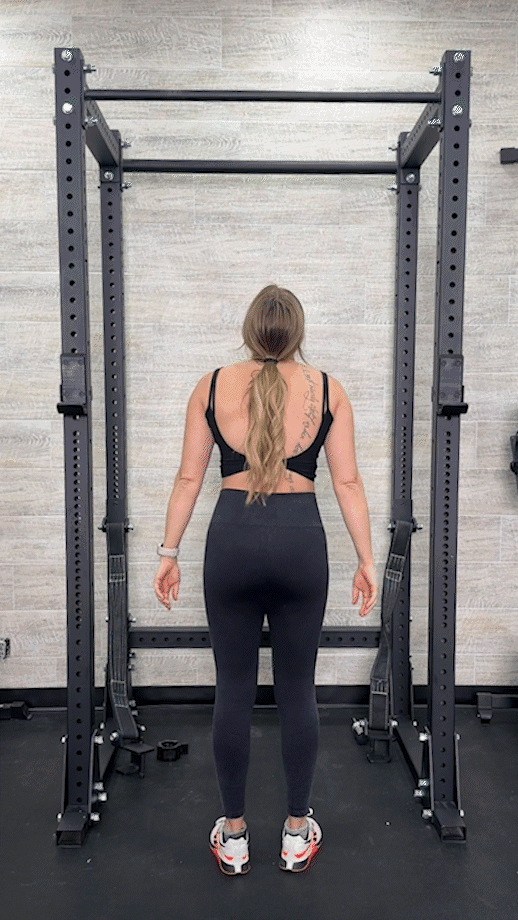
Band-Assisted Pull-Up
Why do it: Band-assisted pull-ups use a resistance band to assist both the concentric and eccentric phases of the exercise, so you have help every step of the way. Plus, you can vary the resistance to allow more or less resistance as needed.
How to do it:
- Secure a resistance band to the pull-up bar.
- Grip the pull-up bar using an overhand grip and step one foot into the loop of the resistance band, dropping into a supported dead hang.
- Use the resistance of the band to pull yourself up toward the bar.
- Continue until the bar reaches about chest level.
- Squeeze the contraction, then slowly lower yourself back down.
- Repeat for reps.
RELATED: Best Pull-Up Assist Bands
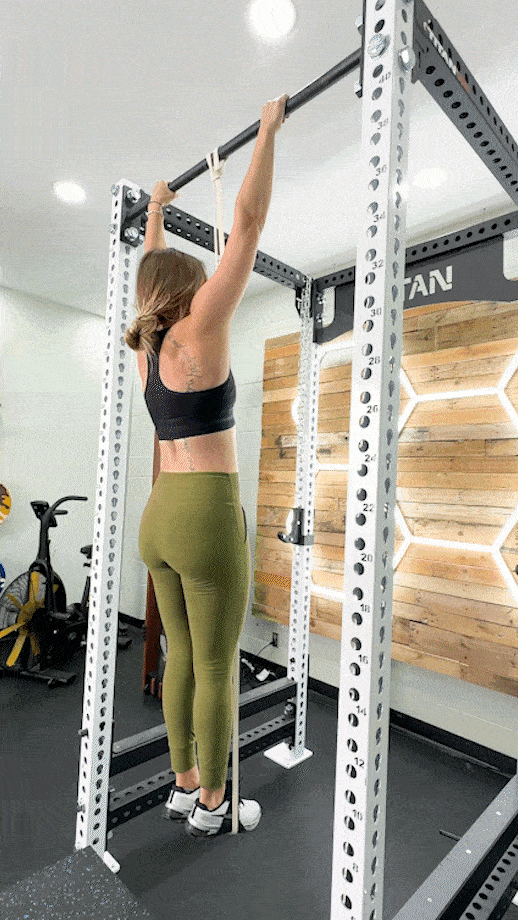
Kipping Pull-Up
Why do it: The CrossFit kids know all about kipping pull-ups, which adds a gymnastics glide kip to the standard pull-up movement. According to Sports Biomechanics2, this variation trades pure upper-body muscle activation for “more full-body activation with the potential to perform more repetitions through reduced upper-body fatigue.”
How to do it:
- Grab a pull-up bar with an overhand grip and begin swinging back and forth from an arched (chest forward, legs back) to a hollow (chest back, legs forward) position.
- From the hollow position, close your hips, then pop them open quickly while pulling hard with your arms and back muscles.
- Pull your body up toward the bar, bringing your shoulders and elbows down.
- Push away from the bar to swing back down and cycle into the next rep.
RELATED: CrossFit Exercises
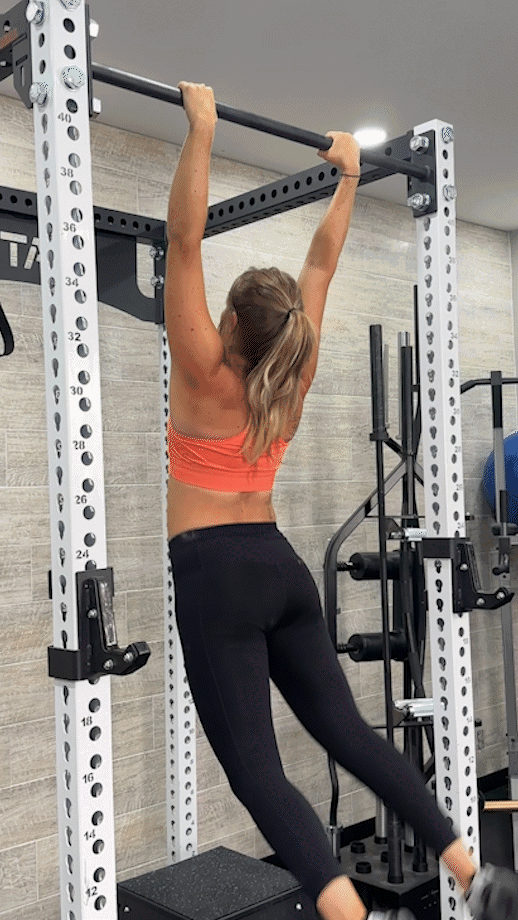
Chest-to-Bar Pull-Up
Why do it: “The chest-to-bar pull-up increases upper-body muscle activation by expanding the exercise’s range of motion,” says Kate. “They can be challenging, even if you’re fairly proficient with regular pull-ups. Beginners may consider kipping pull-ups a stepping stone toward building the strength needed for strict chest-to-bar reps.”
How to do it:
- Grab a pull-up bar with an overhand grip and enter a dead hang.
- Pull your body toward the bar with explosive strength using your arms, shoulders, and back muscles.
- Continue until you touch the bar with your chest or your chest passes over the bar.
- Push away from the bar to swing back down and cycle into the next rep.
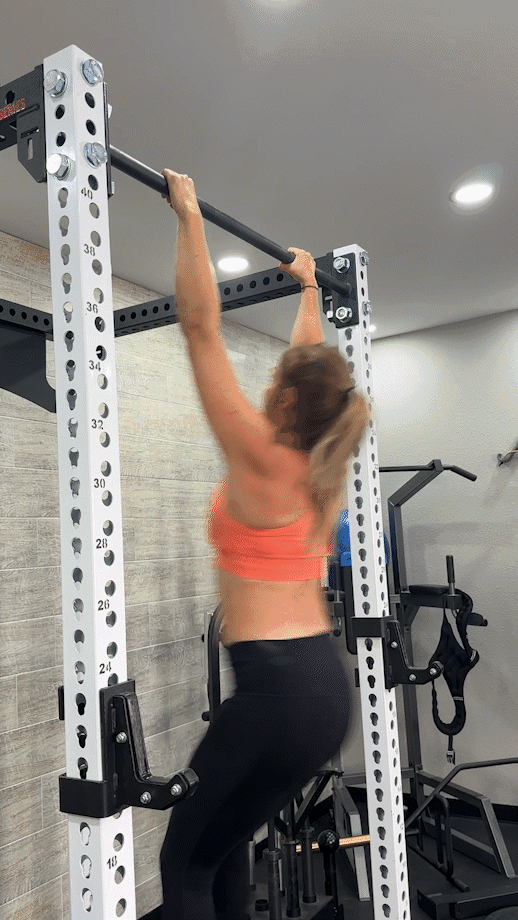
Towel Pull-Up
Why do it: Don’t forget to bring a towel! Draping a towel over the top of your pull-up bar allows you to use a neutral grip, which would normally make things easier, but since it’s a towel, you’ll need tons of grip strength to pull off this variation
How to do it:
- Drape a towel over the top of your pull-up bar and grab hold of each end.
- Enter a dead hang, maintaining a tall chest, tight core, and retracted scapulae.
- Pull yourself up towards the bar, continuing until you reach the top position.
- Squeeze the contraction, then slowly lower yourself back down.
- Repeat for reps.
RELATED: Best Grip Strength Exercises
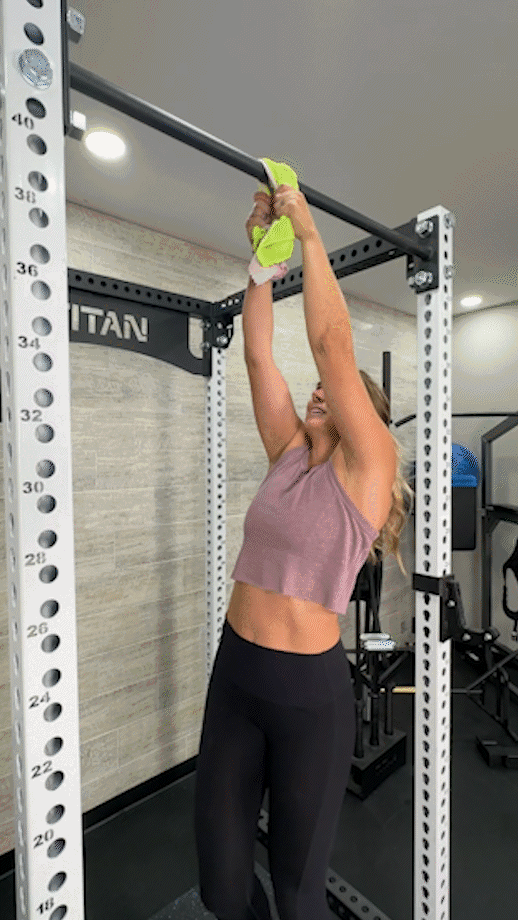
Weighted Pull-Up
Why do it: How do we make most regular exercises more challenging? By adding weight or resistance, of course! The weighted pull-up abides by this principle using a weighted vest or dip belt to allow you to move more than just your own bodyweight during each rep.
How to do it:
- Put on a weighted vest or fasten a dip belt around your waist.
- Grab your pull-up bar and enter a dead hang.
- Pull yourself up toward the bar using your back muscles.
- Continue until the bar reaches chest level, then squeeze your lats.
- Slowly lower yourself back into a dead hang position.
RELATED: Best Weighted Vest
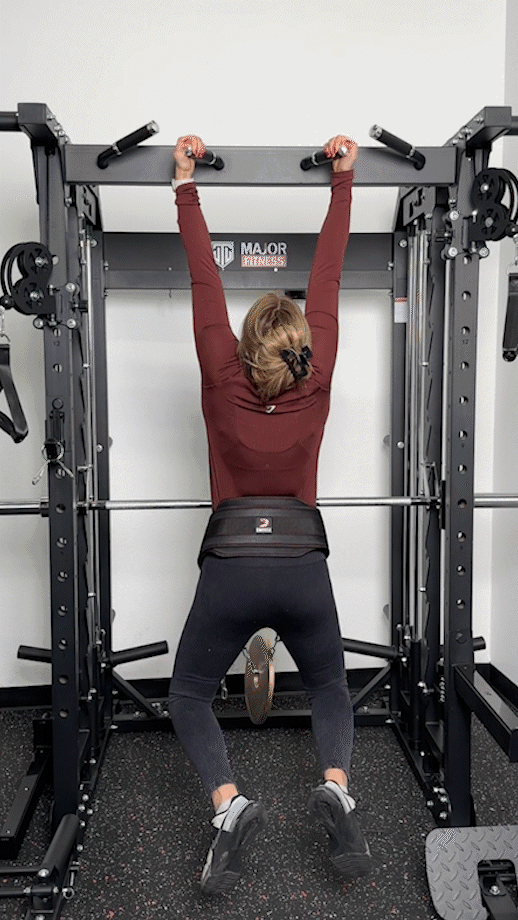
One-Arm Pull-Up
Why do it: As with all unilateral exercises, the single-arm pull-up allows you to target one arm at a time to correct muscle imbalances and address bilateral strength deficits. They’re also great for making jaws drop in the gym.
How to do it:
- Grab onto a pull-up bar with both hands using an overhand grip.
- Enter a dead hang, engage your core, pull your shoulder blades back, and bring your chest up by slightly arching your back.
- Once your form is tight, slowly let go with one arm and hold it at your side.
- Pull yourself up towards the bar using one arm and your back muscles.
- Continue until your elbow reaches full flexion.
- Squeeze the contraction, then slowly lower yourself back down.
- Complete all reps, then switch sides, and repeat the set.
Note: This variation is so advanced that we needed an assist band to perform it ourselves. There’s no shame in doing the same if you’d like to attempt this variation.
RELATED: Unilateral Exercises
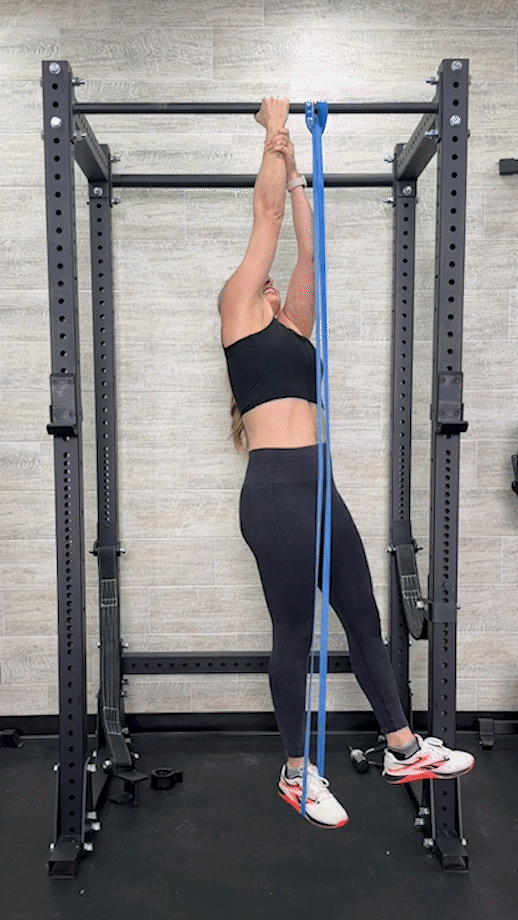
L-Sit Pull-Up
Why do it: “L-sit pull-ups combine two incredible exercises: the pull-up and the L-sit,” says Kate. “By holding an isometric L-sit while you do your pull-ups, you’ll get increased core activation for greater core strength and stability.”
How to do it:
- Hold onto a pull-up bar with an overhand grip.
- Bring your chest forward, tighten your core, and lift your legs until they are fully extended in front of you. Your body should resemble the letter “L.”
- Pull yourself up towards the bar using your back muscles, holding the L-sit as you move.
- Squeeze the contraction, then slowly lower yourself back down.
- Repeat for reps.
RELATED: Functional Core Exercises
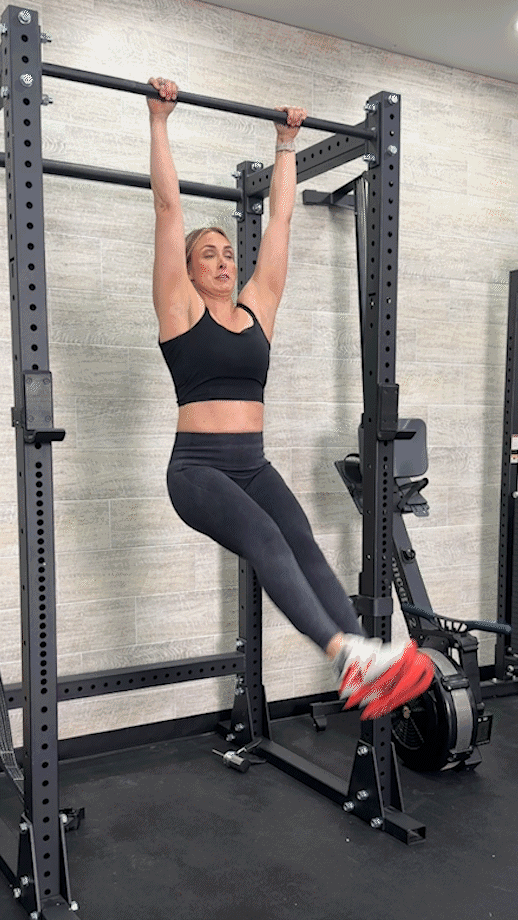
Typewriter Pull-Up
Why do it: Sometimes called “corn cob pull-ups,” this variation involves getting to the top position, holding yourself up there, and moving from left to right. It will annihilate your upper back muscles, arms, and core, making it a very advanced pull-up variation.
How to do it:
- Grab your pull-up bar with a grip that’s wider than shoulder-width and enter a dead hang.
- Tighten your core, retract your shoulder blades, and bring your chest up.
- Pull yourself up toward the bar using your back muscles.
- Hold the top position, then slide your body to the left, extending your right arm as you move, then back to center.
- Now, move your body to the right, extending your left arm, and again returning to center.
- Slowly return to the starting position, controlling your descent.
- Repeat for reps or duration.
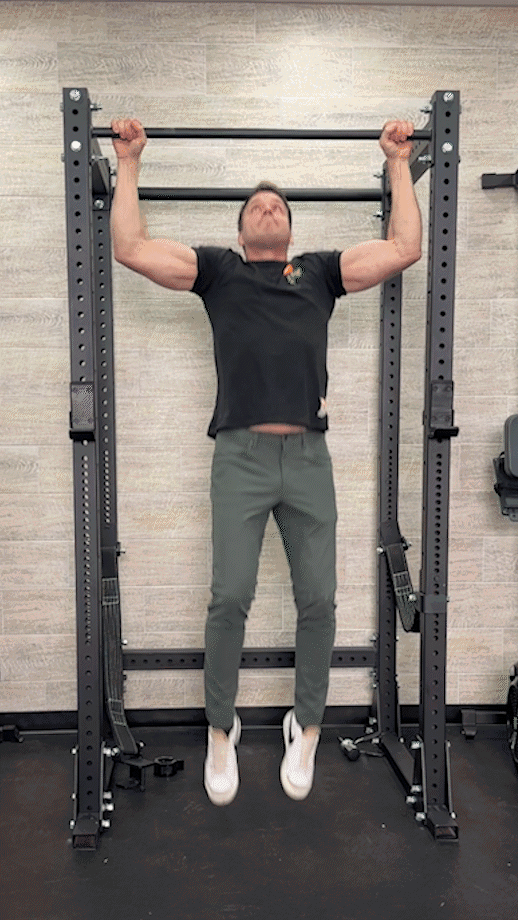
Archer Pull-Up
Why do it: Archer pull-ups are among the most impressive calisthenics movements, serving as a more challenging progression of the already incredibly difficult typewriter pull-up. Performing archer pull-ups works many muscle groups simultaneously and helps prime the body for learning other dynamic calisthenics movements like bar muscle-ups.
How to do it:
- Take hold of a pull-up bar with a wide overhand grip and enter a dead hang.
- Pull your body upwards using only one arm, keeping the other straight as you ascend.
- As you approach the top position, you will resemble an archer preparing to shoot an arrow, thus the name. Bring your chin to or over the bar and let the hand of your extended arm move above the bar as well.
- Squeeze the contraction, then slowly lower yourself back down.
- Repeat the movement, now using the other arm to pull.
- Continue, alternating sides each rep, until the set is complete.
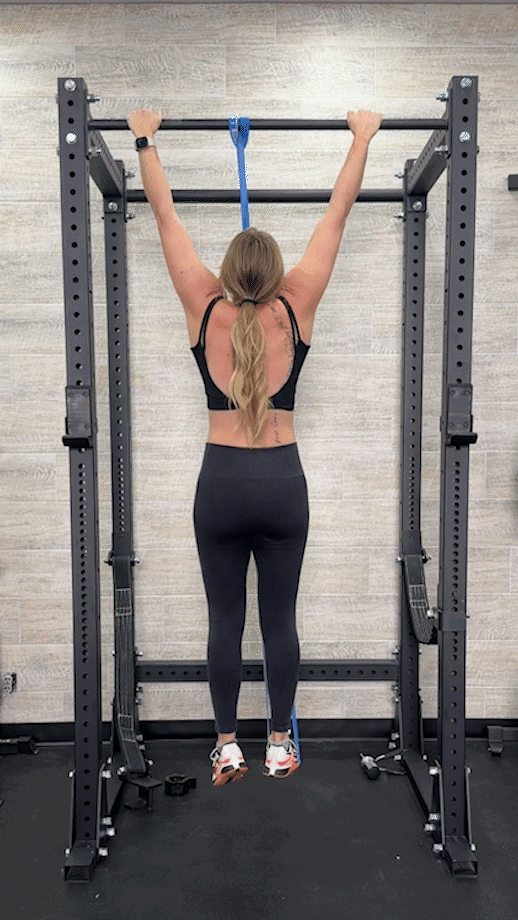
Benefits of Pull-Up Variations
Pull-up variations can take the entry barriers of standard pull-ups away for newcomers and help seasoned pullers-up accomplish amazing feats of strength. Benefits include:
Incredible Upper-Body Muscle Activation
A 2017 study in the Journal of Electromyography and Kinesiology3 noted great EMG activity throughout the upper body, including the back, arms, chest, shoulders, and core, while doing pull-ups and pull-up variations.
Therefore, pull-ups make an effective inclusion for any training program designed to increase muscle strength, size, or endurance.
Beginner-Friendly
Well, the standard pull-up isn’t inherently beginner-friendly, but the fact that there are so many variations designed to modify the movement and make it more manageable means that even those struggling to perform a single pull-up rep can still use pull-up variations in their training to build muscle required for a full pull-up.
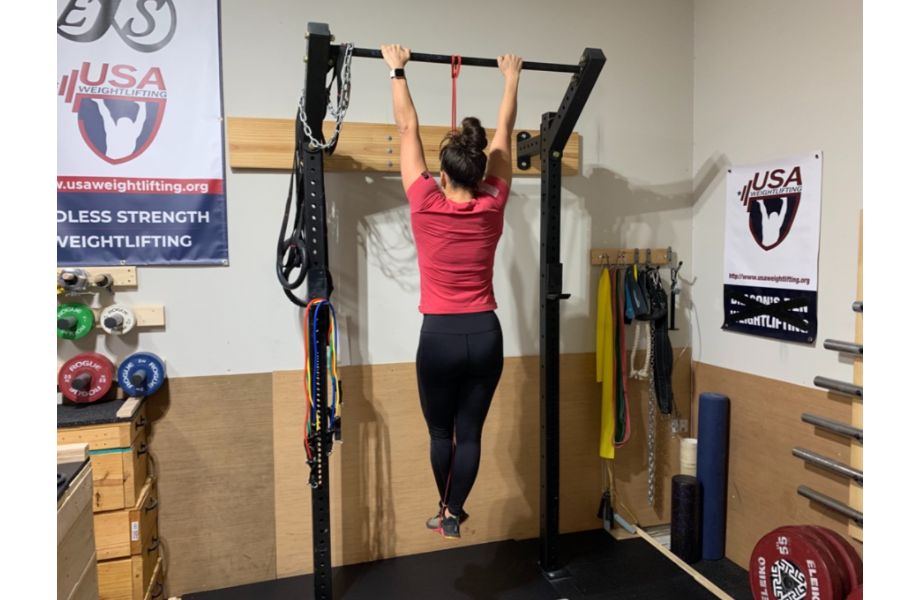
You can also try our 30-day pull-up progression plan.
Requires Minimal Equipment
Another benefit of pull-up variations is that they require very little equipment. Generally speaking, all you need is a pull-up bar, many of which are inexpensive.
Some variations will require some additional stuff—like resistance bands or an elevated surface—but nothing you would need to buy to perform a pull-up variation will ever be as expensive as a specialty rig or machine for your home gym.
Given this, there’s really no reason every home gym owner shouldn’t invest in a pull-up bar.
RELATED: Best Home Gym Equipment
How To Program Pull-Up Variations
Programming bodyweight exercises like pull-ups, chin-ups, and push-ups can be more complicated than your standard weightlifting exercises, where the option to add weight is always there. Therefore, how you program your pull-up variations will depend highly on your skill level.
“First, choose a variation you can manage for a few sets,” says Kate Meier, NASM-CPT, USAW-L1, CF-L1. “Beginners might choose, for example, inverted rows, jumping pull-ups, or band-assisted pull-ups, while someone intermediate may pick regular pull-ups, kipping pull-ups, or chest-to-bar.”
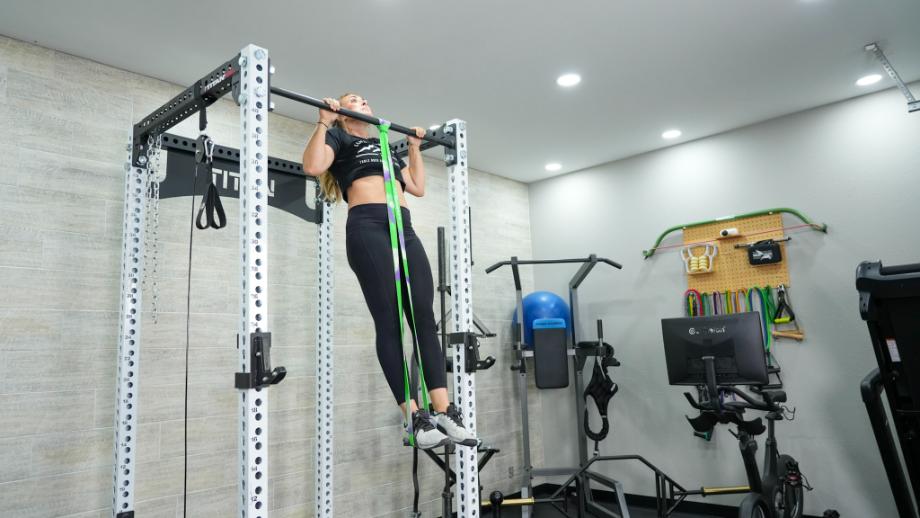
Once you’ve chosen your variations, you’ll need a rep scheme that works with your goals:
- For strength gains: Choose a challenging variation and perform 3 to 5 sets of 5 reps.
- For hypertrophy: Choose a variation you can do for 10 reps and complete 3 to 5 sets.
- For endurance: Choose a mildly challenging variation and do 2 sets of 10 to 15 reps.
“For endurance, ‘cashing out’ on the last set is always a good way to finish,” says Kate. “Perform your working sets as prescribed, rest appropriately, then do one final set until you reach muscle failure.”
RELATED: How Many Reps To Build Muscle
Pull-Up Variations: Final Thoughts
Pull-ups are an incredible body weight movement, but they’re no joke. Luckily, even beginners can make use of this excellent exercise by subbing standard pull-ups for any of the many different pull-up variations.
So, don’t be discouraged if you’re among the majority of gym-goers who can’t do a single regular pull-up rep. There are plenty of variations that you can use in the meantime, and eventually, you’ll be knocking out sets of pull-ups with the best of them before progressing to the one-armed version!
Good luck, fitness fam!
Pull-Up Variations: FAQs
What is the hardest type of pull-up?
Standard pull-ups in general are hard, but the hardest types include weighted pull-ups, one-arm pull-ups, L-sit pull-ups, typewriter pull-ups, and archer pull-ups.
What is the most effective pull-up?
“Pull-ups and pull-up variations can all be effective if performed properly,” says GGR Senior Director of Fitness Content Kate Meier, NASM-CPT, USAW-L1, CF-L1. “The important thing is to get a strong pull during the concentric phase and slowly—and I mean slowly—lower yourself down during the eccentric phase. Letting gravity do the work for you will rob you of results!”
What can I replace pull-ups with?
Pull-up variations like negative pull-ups, inverted rows, and dead hangs make great substitutes while building your back and grip strength. Other alternatives to pull-ups that work the same muscles include lat pulldowns, seated rows, bent-over barbell rows, and dumbbell pullovers.
How can I simulate pull-ups at home?
You can simulate the muscle stimulus provided by pull-ups by performing bodyweight (inverted) rows in a doorway or using a broomstick (or any sturdy pole) and two chairs.
That said, a pull-up bar is an inexpensive piece of equipment that yields attractive fitness dividends. Many bars don’t need to be wall mounted and can be attached to your doorway, so you can get in your reps and take it down when finished.
References
1. Jennifer K H, Daniel A J, Todd C. A Comparison of Muscle Activation during the Pull-up and Three Alternative Pulling Exercises. J Phy Fit Treatment & Sports. 2018; 5(4): 555669. DOI: 10.19080/JPFMTS.2018.05.555669.
2. Dinunzio C, Porter N, Van Scoy J, Cordice D, McCulloch RS. Alterations in kinematics and muscle activation patterns with the addition of a kipping action during a pull-up activity. Sports Biomech. 2019;18(6):622-635. doi:10.1080/14763141.2018.1452971
3. Dickie JA, Faulkner JA, Barnes MJ, Lark SD. Electromyographic analysis of muscle activation during pull-up variations. J Electromyogr Kinesiol. 2017;32:30-36. doi:10.1016/j.jelekin.2016.11.004


